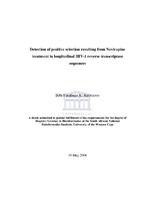Detection of positive selection resulting from Nevirapine treatment in longitudinal HIV-1 reverse transcriptase sequences
Abstract
Nevirapine (NVP) is a cheap anti-retroviral drug used in poor countries worldwide, administered to pregnant women at the onset of labour to inhibit HIV enzyme reverse transcriptase. Viruses which may get transmitted to newborns are deficient in this enzyme, and HIV-1 infection cannot be established, thereby preventing mother to child transmission (MTCT). In some cases, babies get infected and positive selection for viruses resistant to nevirapine may be inferred. Positive selection can be inferred from sequence data, when the rate of nonsynonymous substitutions is significantly greater than the rate of synonymous substitutions. Unfortunately, it is found that available positive selection methods should not be used to analyse before- and after- NVP treatment sequence pairs associated with MTCT. Methods which use phylogenetic trees to infer positive selection trace synonymous and nonsynonymous substitutions further back in time than the short time duration during which selection for NVP occurred. The other group of methods for inferring positive selection, the pairwise methods, do not have appreciable power, because they average susbtituion rates over all codons in a sequence pair and not just at single codons. We introduce a simple counting method which we call the Pairwise Homologous Codons (PHoCs) method with which we have inferred positive selection resulting from NVP treatment in longitudinal HIV-1 reverse transcriptase sequences. The PHoCs method estimates rates of substitutions between before- and after- NVP treatment codons, using a simple pairwise method.

